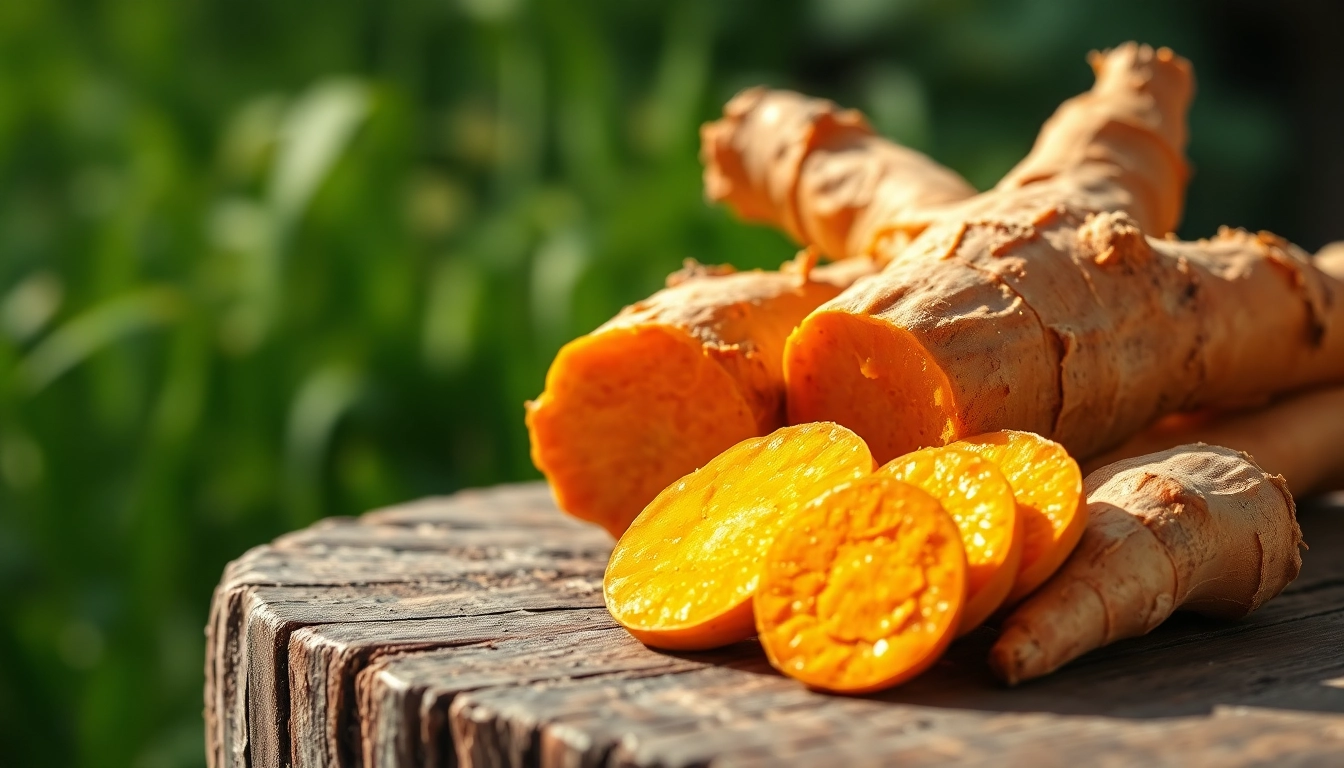Understanding Turmeric Root
What is Turmeric Root?
Turmeric root, scientifically known as Curcuma longa, is the underground rhizome of a flowering plant belonging to the ginger family. Its vibrant yellow-orange color has made it a staple in culinary applications, particularly in South Asian cuisine, where it’s a key ingredient in curry powders and various dishes. Beyond its aesthetic appeal and flavor enhancement, turmeric root has been revered for its potential health benefits, largely attributed to its primary active compound, curcumin. This spice not only acts as a natural coloring agent but also serves as a fundamental component in traditional medicine across various cultures, especially Ayurvedic practices.
History and Uses of Turmeric Root
Turmeric has a rich history that spans thousands of years, originating from Southeast Asia, particularly India. Historically, it has been used as a dye, a spice, and a medicinal herb. Ancient Ayurvedic texts highlighted its therapeutic properties, noting its effectiveness in treating a variety of ailments including digestive issues, inflammation, and skin conditions. In addition to its extensive use in culinary arts, turmeric played an important role in religious ceremonies and traditional rituals across cultures. As it gained attention in the Western world, its applications expanded, inspiring a surge in dietary supplements and wellness products centered around turmeric root.
Varieties of Turmeric Root
There are several varieties of turmeric root, each varying slightly in flavor, appearance, and chemical composition. The most common include:
- Common Turmeric (Curcuma longa): The most widely used variety, typical in South Asian cooking.
- Wild Turmeric (Curcuma aromatica): Known for its distinct aroma and slightly bitter taste, often used in traditional medicine.
- White Turmeric (Curcuma zedoaria): Distinguished by its white color, it has a less intense flavor compared to common turmeric and is popular in Southeast Asian cuisines.
Each variety offers unique applications, but they all share the potent health properties attributed to curcumin.
Health Benefits of Turmeric Root
Anti-inflammatory Properties of Turmeric Root
One of the most celebrated benefits of turmeric root lies in its powerful anti-inflammatory properties. Chronic inflammation is linked to various health conditions, including heart disease, cancer, and neurodegenerative disorders. Curcumin, the active ingredient in turmeric, has been shown to inhibit various inflammatory markers in the body. A multitude of studies suggest that incorporating turmeric root into one’s diet can significantly reduce inflammation levels and enhance overall health.
Antioxidant Effects of Turmeric Root
In addition to its anti-inflammatory benefits, turmeric root is rich in antioxidants, which play a crucial role in neutralizing free radicals in the body. Free radicals can cause oxidative stress, leading to cellular damage and contributing to aging and various diseases. Curcumin enhances the body’s own antioxidant mechanisms, promoting a balanced state of cellular health. By regularly consuming turmeric root, individuals can bolster their body’s defenses against oxidative stress, thus potentially reducing the risk of chronic diseases.
Potential Benefits for Digestion and Skin Health
Turmeric root has been traditionally used to support digestive health. It may help in alleviating symptoms of bloating, gas, and indigestion. Research indicates that curcumin can promote bile formation in the liver, which is vital for effective digestion. Additionally, its anti-inflammatory properties can aid in the management of gastrointestinal disorders.
Turmeric root has also found a place in skincare due to its antibacterial and anti-inflammatory properties. It may assist in managing skin conditions like acne and psoriasis. Moreover, turmeric root can enhance skin radiance, making it a popular ingredient in face masks and creams.
Culinary Applications of Turmeric Root
How to Use Turmeric Root in Cooking
Introducing turmeric root into your culinary repertoire can add flavor, color, and nutrition. Fresh turmeric root can be grated, sliced, or crushed and used in a variety of dishes. It pairs well with:
- Soups and stews, where it infuses a warm, earthy flavor.
- Curries, acting as a foundational spice.
- Smoothies, providing a nutritional boost.
- Teas, where it can be combined with ginger and lemon for a soothing beverage.
For the most benefit, pair it with black pepper, which enhances the absorption of curcumin in the body.
Popular Recipes Featuring Turmeric Root
Here are a few delicious recipes that highlight the versatile use of turmeric root:
- Golden Milk: A comforting drink made from milk, turmeric root, black pepper, and spices like cinnamon.
- Turmeric Rice: Basmati rice flavored with turmeric root, garlic, and sautéed vegetables makes for a vibrant side dish.
- Turmeric Ginger Tea: Boil fresh turmeric and ginger together, strain, and enjoy this warm health-boosting beverage.
Pairing Turmeric Root With Other Ingredients
Turmeric root is remarkably versatile and can be paired with various ingredients to enhance its flavor and health benefits. Foods that complement turmeric root well include:
- Black Pepper: Increases curcumin absorption.
- Coconut Milk: Balances the earthy taste of turmeric in curries and stews.
- Ginger: Both a flavor booster and an ally in digestive health.
Experimenting with different combinations can yield numerous creative and healthful dishes.
Buying and Storing Turmeric Root
Where to Buy Fresh Turmeric Root
Fresh turmeric root can be found in various grocery stores, especially those specializing in organic and international foods. Local farmers’ markets may also carry fresh turmeric. For convenience, online retailers such as Turmeric Root provide options for procurement, ensuring quality and freshness.
How to Store Turmeric Root for Longevity
To maximize the shelf life of fresh turmeric root, follow these storage guidelines:
- Refrigeration: Store in a paper bag in the refrigerator, where it can last for up to two weeks.
- Freezing: For longer storage, freeze turmeric root by wrapping it in foil or placing it in an airtight container.
- Drying: Dehydrated turmeric root can be stored in an airtight jar in a cool, dark place for months.
Identifying Quality Turmeric Root
When purchasing turmeric root, quality is crucial for obtaining the best flavor and health benefits. Look for:
- Firm, plump roots without soft spots or mold.
- Bright orange color, indicating high curcumin content.
- A strong, earthy aroma, signaling freshness.
These signs can help you choose the highest quality turmeric root, whether fresh or dried.
Conclusion: Embrace the Power of Turmeric Root
Final Thoughts on Incorporating Turmeric Root
Turmeric root is a powerful addition to any diet, providing a multitude of health benefits along with culinary versatility. As studies continue to emerge about its health properties, incorporating turmeric root into your daily routine can be a simple yet impactful way to support your well-being.
Encouragement to Experiment with Turmeric Root
Whether you prefer it fresh, powdered, or in extract form, turmeric root can enhance your meals and contribute to improved health. Don’t hesitate to experiment with flavors and recipes, making this ancient spice a modern staple in your kitchen.
Future Research on Turmeric Root Benefits
As scientific research continues to explore the myriad benefits of turmeric root, more information will become available on its health effects. Staying informed can help you make the most out of this remarkable root, aligning its usage with your health goals. Embrace the journey of health through the enriching properties of turmeric root.



